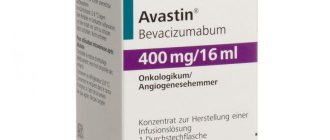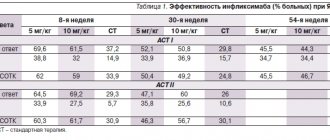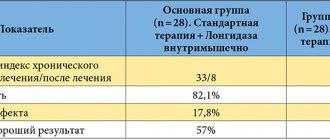Pharmacological properties of the drug Cisplatin
Antitumor agent, platinum compound. The mechanism of action is probably due to the binding of cisplatin to cell DNA with the formation of intra- and interhelical cross-links, which change the structure and suppress DNA synthesis. To a lesser extent, cisplatin inhibits protein and RNA synthesis. Cisplatin does not have phase specificity. After intravenous administration, the pharmacokinetic parameters of cisplatin are described by a two-phase pharmacokinetic model. The initial phase is rapid, with a half-life of 29–45 minutes, followed by a long phase with a half-life of 2–4 days. This duration of the elimination phase is likely due to the high degree of protein binding. Typically, more than 90% of cisplatin is bound to plasma proteins, but with slow IV administration this figure may be higher. It is excreted mainly in the urine. About 15–25% of the dose is excreted quickly, mainly as unchanged substance in the first 2–4 hours and 20–75% in the first 24 hours. The remaining amount binds to tissues and blood plasma proteins. Cisplatin appears to accumulate in the kidneys, liver, small intestine and testes. It does not penetrate the BBB and is not detected in the CSF in significant quantities. Its level in the CSF is low, although significant amounts can be detected in brain tumors.
Metastatic stomach cancer
Treatment options for metastatic tumors are based on the patient's general condition, which is determined by their daily activities and ability to perform daily tasks and activities. The doctor assesses your general condition using one of the two systems described below.
ECOG scale (Eastern Cooperative Oncology Group):
- 0 points—the patient is fully active;
- 1 point - the patient can fully cope with self-care, but it is difficult for him to perform heavy physical work;
- 2 points - the patient is capable of self-care and spends most of his waking time out of bed, but cannot perform any work;
- 3 points - the patient is not able to fully cope with self-care, cannot perform any work and spends most of his waking time in bed;
- 4 points - the patient is completely dependent on outside help.
Karnofsky Performance Status KPS:
- index from 0% to 49% - the patient is not able to care for himself;
- index from 50% to 79% - the patient cannot perform active work and partially needs help;
- index from 80% to 100% - the patient maintains normal activity.
Poor general condition:
If a patient has an ECOG score of 3 or 4, or a KPS of 0 to 59, they are considered to have poor general condition. This means that chemotherapy will likely be too dangerous. In this case, supportive care may be the best treatment option.
Good general condition:
If the ECOG score is 0, 1 or 2, or the KPS is between 60 and 100 points, the patient is considered to be in good general condition. This means he has several options for treating cancer.
Where to start treating metastatic stomach cancer?
Testing should be done to identify tumor markers. These can be used to determine what systemic therapy you may receive:
- HER2;
- PD-L1;
- microsatellite instability (MSI) or abnormalities in the MMR-dMMR system.
For patients with good general status, the following treatments may be used:
- chemoradiotherapy;
- systemic therapy;
- palliative care.
Chemoradiation therapy
A combination of chemotherapy and radiation therapy. This option is suitable for patients who are not candidates for surgery and have not yet received chemotherapy.
Chemotherapy regimens recommended for use in radiotherapy:
- fluorouracil and oxaliplatin;
- fluorouracil and cisplatin;
- fluoropyrimidines (fluorouracil or capecitabine) and paclitaxel.
Systemic therapy
The term "systemic therapy" is used when talking about treating cancer throughout the body. There are first-line treatment drugs that are recommended to start treatment with, since their use has the best results.
First-line systemic therapy
| Preferred Modes | Fluoropyrimidines (fluorouracil or capecitabine) and oxaliplatin |
| Fluoropyrimidines (fluorouracil or capecitabine) and cisplatin | |
| Other recommended modes | Paclitaxel with cisplatin or carboplatin |
| Docetaxel with cisplatin | |
| Fluoropyrimidines (fluorouracil or capecitabine) | |
| Docetaxel | |
| Paclitaxel | |
| Fluorouracil and irinotecan | |
| Docetaxel, cisplatin and fluorouracil | |
| Docetaxel, oxaliplatin and fluorouracil | |
| Docetaxel, carboplatin and fluorouracil | |
| ECF (epirubicin, cisplatin and fluorouracil) | |
| Epirubicin, oxaliplatin and fluorouracil | |
| Epirubicin, cisplatin and capecitabine | |
| Epirubicin, oxaliplatin and capecitabine | |
| If the tumor is HER2-positive, the targeted Trastuzumab is added to the first-line treatment regimen in addition to chemotherapy. Trastuzumab is not prescribed if epirubicin is included in the treatment regimen. | |
Targeted therapy is a new type of systemic therapy. Trastuzumab is a targeted drug used to treat advanced gastric cancer.
More details
Targeted therapy for stomach cancer
During the consultation, the oncologist at the Rassvet Clinic will prescribe a systemic therapy regimen based on data about the patient’s general health and information about the side effects of his treatment.
Two-drug regimens have fewer side effects than three-drug regimens. If you are prescribed fluorouracil (5-FU), leucovorin may be added to your regimen to reduce the side effects of chemotherapy. Regardless of your prescribed medication regimen, you should be examined and tested regularly to evaluate and check for side effects.
If the tumor does not respond to first-line regimens, the subsequent treatment regimen is adjusted depending on the previous treatment regimen and the general health of the patient.
Below are the regimens that have proven to be the most effective in clinical trials as second and subsequent lines of therapy.
Treatment if first-line drugs are ineffective
| Preferred Modes | Ramucirumab and paclitaxel |
| Docetaxel | |
| Paclitaxel | |
| Irinotecan | |
| Trifluridine or tipiracil (third and subsequent line therapy) | |
| Fluorouracil and irinotecan | |
| Pemprolizumab (third and subsequent line therapy, for MSI-H or dMMR tumors) | |
| Other recommended modes | Ramucirumab |
| Irinotecan and cisplatin | |
| Pemprolizumab (third and subsequent line therapy, for patients with PD-L1 marker) | |
| Docetaxel and irinotecan |
Palliative care
Palliative care is specialized medical care aimed at relieving pain and other symptoms of a serious illness. Palliative care specialists work with the patient, the patient's family, and other health care providers to provide a level of support that complements ongoing treatment and care. Palliative care may be used during aggressive procedures such as surgery, chemotherapy, or radiation therapy.
When palliative care is used in conjunction with all other appropriate treatments, cancer patients feel better and tolerate treatment better.
At the Rassvet Clinic, palliative care is provided by a team of doctors, nurses and other specialists. Palliative care teams strive to improve the quality of life for people with cancer and their families. This form of care is offered with most types of treatment a patient may receive.
Good to know
Why is chemotherapy at the Rassvet clinic a good solution?
Use of the drug Cisplatin
When used as monotherapy in children and adults, the doses and schedule of administration are as follows: 50–100 mg/m2 body surface as a single infusion over 6–8 hours every 3–4 weeks; IV or slow infusion of 15–20 mg/m2 daily for 5 days every 3–4 weeks. The dose should be reduced in patients with depressed bone marrow function. Repeated courses of cisplatin administration should not be started until:
- a) the level of creatinine in the blood serum will not decrease to 140 µmol/l; the level of urea in the blood plasma will not decrease to 9 mmol/l.
- b) the number of formed elements in the peripheral blood will not reach an acceptable level (platelets more than 100,000 per 1 mm3, leukocytes - more than 4000 per 1 mm3).
A basal audiogram should be performed and patients should be periodically assessed to determine hearing acuity. Patients should be adequately hydrated before and for 24 hours after cisplatin administration to ensure adequate diuresis and reduce nephrotoxicity. Hydration can be achieved by intravenous infusion of 2 liters of 5% glucose solution with the addition of 1/2–1/3 volume of 0.9% sodium chloride solution over 2–4 hours. The required amount of cisplatin for injection should be added to 1 liter of 0.9% sodium chloride solution and pour in for the required time. It is important to maintain adequate hydration and diuresis for 24 hours after cisplatin infusion. This can be achieved by administering 1–2 liters of 0.9% sodium chloride solution or a mixture of glucose and 0.9% sodium chloride solution for 6–12 hours. Cisplatin is usually used in combination therapy with the following cytotoxic drugs: in the treatment testicular cancer - vinblastine, bleomycin, actinomycin; in the treatment of ovarian cancer - cyclophosphamide, doxorubicin, hexamethylmelamine, fluorouracil; in the treatment of head and neck cancer - bleomycin and methotrexate. The dose is set in accordance with the chemotherapy regimen used.
What to do if the tumor cannot be removed surgically?
If you are healthy enough to have major surgery, but the tumor is so widespread that surgery will not be successful, you have other treatment options.
- Chemoradiation therapy as an attempt to cure cancer. It is also called radical chemoradiotherapy.
Chemotherapy regimens recommended for radical chemoradiotherapy
| Preferred Modes | Fluorouracil and oxaliplatin |
| Fluorouracil and cisplatin | |
| Fluoropyrimidines (fluorouracil or capecitabine) and paclitaxel |
- Systemic chemotherapy (see “Metastatic gastric cancer”).
Side effects of the drug Cisplatin
From the urinary system - cumulative, dose-dependent renal failure is the main toxicity factor limiting the dose of cisplatin. The most commonly observed decrease in glomerular filtration, manifested by an increase in serum creatinine levels. Adequate hydration before and after treatment may reduce the severity of nephrotoxicity. From the hematopoietic system , hematological toxicity is also dose-dependent and cumulative. The lowest platelet and white blood cell counts are usually observed between days 18 and 32 and return to baseline levels in most patients after 39 days. Leukopenia and thrombocytopenia are more pronounced when cisplatin is used in doses exceeding 50 mg/m2. Subsequent courses of cisplatin should not be started until the platelet count exceeds 100,000 per mm3 and the white blood cell count exceeds 4000 per mm3. A significant number of patients experience anemia (decrease in hemoglobin by more than 2 g%) - usually after several courses of treatment. In severe cases, red blood cell transfusion may be required. Cisplatin therapy can cause the development of hemolytic anemia with a positive Coombs test. Subsequent courses of cisplatin treatment may cause increased hemolysis in susceptible patients. On the part of the digestive system , nausea and vomiting develop in almost all patients receiving treatment with cisplatin; in some cases, they are so pronounced that there is a need to reduce the dose or discontinue treatment. There was an increase in the activity of AST and alkaline phosphatase with clinical signs of toxic effects on the liver. From the central nervous system and sensory organs - cumulative ototoxicity develops mainly when used in high doses. Commonly observed signs of ototoxicity are tinnitus or hearing loss. Tinnitus usually lasts from several hours to 1 week after stopping therapy. Hearing loss may be unilateral or bilateral in the range of 40,000–8000 Hz (in 10–30% of patients). The frequency and severity of such hearing damage increases with repeated courses and may be irreversible. Peripheral neuropathies include stocking-glove paresthesias, areflexia, and loss of vibration sensation, especially when cisplatin is given in high doses or more frequently than recommended. These neuropathies may be irreversible. Optic neuritis has been reported following the use of cisplatin. With long-term therapy, myasthenic syndrome and seizures may also occur (if such phenomena develop, cisplatin should be discontinued). Effect on Homeostasis: Hypomagnesemia and hypocalcemia may occur and manifest as muscle excitability or spasms, tremors, carpopedal spasms, and/or tetany. Hyperuricemia may develop, especially when using doses exceeding 50 mg/m2. Uric acid levels peak 3–5 days after cisplatin administration. Allergic reactions - anaphylactoid reactions, manifested mainly by facial swelling, dizziness, tachycardia, skin rashes and arterial hypotension. Reactions usually develop within a few minutes after administration of cisplatin; to eliminate them, epinephrine, corticosteroids and/or antihistamines are administered intravenously.
What to do if the cancer comes back?
A recurrence that occurs close to where the stomach was located (if you had a complete stomach removal) is called a locoregional recurrence . If the cancer comes back and spreads to areas distant from the stomach, it is metastatic disease .
Treatment of locoregional relapse largely depends on two factors:
- whether your health condition allows surgical treatment,
- whether the spread of the tumor allows for a successful operation.
If surgery is not possible, supportive care may be an alternative (see below “Metastatic gastric cancer”).
Special instructions for the use of Cisplatin
Treatment with cisplatin should only be administered by a physician experienced in chemotherapy. To reduce the risk of nephrotoxicity, patients should be hydrated before, during and after therapy. Before starting treatment, and then before administering subsequent doses, it is necessary to monitor the following parameters: renal function, including the level of glomerular filtration, urea nitrogen, creatinine in the blood; water and electrolyte balance to detect hypermagnesemia and hypercalcemia; hearing function; number of red blood cells, white blood cells and platelets; liver function and neurological status. The drug should be prescribed with caution to patients with impaired liver and kidney function. Patients receiving cisplatin should be monitored for early detection of possible anaphylactoid reactions; To treat these types of reactions, medications and necessary equipment must always be available. The risk of developing anaphylactoid reactions is increased in patients with a hereditary predisposition to allergic diseases. Children are more likely to develop ototoxicity than adults. Cisplatin has a mutagenic, teratogenic and embryotoxic effect. Cisplatin should be prescribed to women of reproductive age only in cases where the expected therapeutic effect outweighs the risk of such therapy, and patients in this case should use reliable contraception. If pregnancy occurs while using cisplatin, the patient should be informed of the possible harmful effects on the fetus.
Is chemotherapy necessary if surgical treatment was performed at the first stage?
If treatment began with surgery, the results of surgery are used to decide whether further treatment is necessary.
The surgeon cannot always remove all the tumor he sees. Preoperative examination has certain errors, and the true spread of the tumor is visible only during surgery. If during the operation it becomes clear that the tumor has spread to structures that cannot be removed, the main component of the tumor is removed (if possible), but part of the tumor remains. This operation does not cure, but it reduces the symptoms of the disease and increases the likelihood of a positive response to chemotherapy and radiation therapy, because The smaller the tumor volume, the higher the likelihood of response to treatment.
Systemic therapy for non-small cell lung cancer (NSCLC)
Systemic therapy is the use of drugs to kill cancer cells.
The drugs travel through the bloodstream throughout the body and affect cancer cells. Typically, systemic therapy involves injecting solutions into a vein or using tablets and capsules. Types of systemic therapy for treating NSCLC include:
- chemotherapy;
- targeted therapy;
- immunotherapy.
A person may receive one type of systemic therapy or a combination of drugs. Systemic therapy may also complement treatments such as surgery and/or radiation therapy.
Immunotherapy
Immunotherapy is a relatively new treatment for some types of lung cancer. Although any cancer treatment may cause side effects, immunotherapy is generally well tolerated; this is partly due to its mechanism of action.
The immune system is constantly working to keep us healthy. It recognizes and fights dangers such as infections, viruses and cancer cell growth. Immunotherapy uses a person's own immune system to treat cancer.
In March 2015, the FDA approved the immunotherapy nivolumab for the treatment of metastatic squamous cell NSCLC when previous treatment has failed. Nivolumab works by interfering with a molecular "brake" known as PD-1, which prevents tumors from being attacked by the body's immune system.
In 2021, the FDA approved the new immune drug pembrolizumab for the treatment of advanced NSCLC as first-line therapy. Its therapeutic activity is similar to that of nivolumab. Patients are tested for the presence of PDL-1 protein and, if it is detected in sufficient quantities, this is a criterion for prescribing these drugs.


